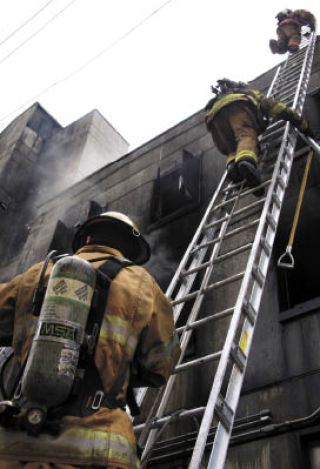Timothy Wilson started assessing the burning six-story building as his team’s fire engine pulled up to the scene. Smoke was pouring through several windows, and he didn’t know if anyone was inside. Time was ticking away.
As another team attacked the fire from the building’s rear, Wilson’s team hoisted ladders up against the scorched structure. The firefighters scaled the ladders, laying siege to the building. Pry bars and whirring chain saws — tools for tearing open the roof — hung form their wrists. The holes would let the heat escape, cooling the inferno and allowing the firefighters to methodically extinguish every wisp of flame.
Firefighters spend their lives training for somebody’s worst day, and like any dedicated professional, they can’t help but want to do their job.
“It’s a horrible thing to say — you look forward to someone’s worst day,” Wilson said after the fire had been put out. Soot covered his flame-resistant jacket and pants. Water lapped around his boots.
But “you train to do a job, and you look forward to doing it,” he said.
On this day, the fire had been set for training. No one’s worst day had been realized.
For 11 weeks, Wilson has been been training with a couple dozen fellow cadets of Recruit Class 0901 at the Washington State Patrol’s North Bend Fire Training Academy.
Tucked in a fold in the Cascades’ western slope off Exit 38 on Interstate 90, the school’s campus looks like a war zone. It is a hodgepodge of burnt-out structures, car frames, dumpsters and other scorched skeletons of everyday life.
The academy is one of the few schools to practice fighting aircraft fires with real jet fuel, and departments from across the country come to train here.
Dominating the school is its burn building, where Wilson and his fellow cadets learned how to fight building fires.
The cadets are from across Puget Sound, and will go their separate ways after graduation on Friday, May 1. Wilson will go to Redmond Fire Department.
It will be bittersweet for Wilson, who’s become close with his fellow recruits. His classmates quickly dubbed Wilson “Wing Nut” for his goofy personality. He has learned everyone’s strengths and weaknesses and they have learned his — a necessity when you go into a burning building.
Why do firefighters run into buildings on fire?
“It’s because of the people you work with,” Wilson explained.
He trusts his life with every one of his fellow cadets, he said.
One of those people is Yancey Kangas, a recruit from Lynnwood Fire Department with a boyish grin. He got into firefighting after stints in social work and construction.
“You see more fire here in 11 to 12 weeks than some people do in a career,” he said.
The academy teaches cadets about fire science — how to read a fire and how to fight it safely. Entering a burning building, he is constantly reading the conditions — how hot is the door handle? Is there light or dark smoke?
It is a privilege to train the recruits and see them become confident and competent firefighters, said Lieutenant Rick Peters, of Snohomish County Fire District No. 7. The 20-year veteran is one of seven company officers for Recruit Class 0901 — the designation means it is the first class of 2009. The school trains four classes of 25 recruits a year.
It takes a special kind of person to be a firefighter, Peters said.
“You’ve got to be able to handle the blood and guts and everything that comes with it,” he said. Before working as a firefighter, he was an emergency medical technician.
Fires with children involved are always the hardest ones to deal with, he added.
A firefighter also has to work as part of a tightly-woven team.
It’s a dangerous profession, said Peters, who has three children, but “there’s nothing more rewarding than taking care of people when their world is crumbling.”


